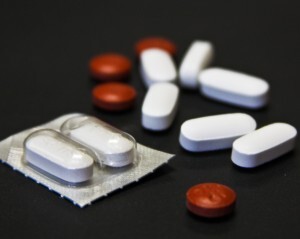
Health care providers in the US wrote 259 million prescriptions for painkillers last year. (Maddi Driggs)
Health care providers in the US wrote 259 million prescriptions for painkillers, enough for every adult in the country to have a bottle of pills, according to the most recent data from the CDC.
The problem is that people often end up with leftover medication that they keep at home, which can be dangerous if misused. This is why the Drug Enforcement Agency sponsored its 10th National Prescription Drug Take-Back Initiative on Sept. 26, which sets up collection sites around the country to encourage local residents to dispose of unused and expired drugs.
'Prescription drugs are often misused and abused, whether it's youth obtaining them from their medicine cabinets at home or just patients who have a need for pain medication but misuse them,” said Brian Alba, who works in drug and alcohol prevention in Utah County. “This is to help get unused and expired medications out of the homes, out of harm’s way and from abuse.”
The Provo collection site was located in front of Macey’s on State Street, and was organized with the help of the Utah County Department of Drug and Alcohol Prevention and Treatment and the Provo Police Department.
The initiative also helps prevent people who don't need the medication from unnecessarily taking it. The CDC states that an average of 46 people die every day from an overdose of painkillers. While it is certainly a nationwide problem, drug overdose remains a particularly large issue in Utah, which ranks fifth highest in the nation for deaths from drug overdose according to the CDC report.
Three times more people died from drug poisonings than from car accidents in Utah in 2013. Many areas of Salt Lake City, Ogden and Carbon County have the highest rates of drug-related deaths while Logan, South Jordan and University of Utah areas have the lowest rates in the state. North Provo, including BYU, has an average rate of drug-related deaths compared to the state, according to data released by the Utah Department of Health.
“Because they're prescribed, I think there is this false sense of security, thinking because a doctor prescribed them that they're probably OK,” said Anna Fondario, who works at the Utah Department of Health. “If they're used as prescribed, that's one thing, but sometimes they're taken in combination with other medications that could be really harmful, like if they're taking it with antidepressants or sleep-aids, or if someone takes more than prescribed.”
In Utah, prescription pain medications such as oxycodone, methadone and hydrocodone are responsible for most drug-related deaths, even more than deaths from heroin and cocaine combined, according to a press release from the Utah Department of Health.
One challenge in combating drug misuse in Utah is the prevalence of leftover medication from prescriptions. The 2015 Behavioral Risk Factor Surveillance Survey found that almost 7 out of 10 Utahns who used prescription pain medication reported keeping leftover medications in their homes.
“When we have 68 percent of Utahns who have used prescription pain medications in the past year keeping their leftover medications, I would say that that’s pretty significant and that we want to get rid of those that are just sitting around,” Fondario said.
So far, the DEA has collected 2,411 tons of drugs through previous Take-Back events, according to a press release from the organization.